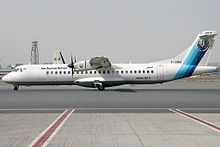
Iranian investigators believe an ATR 72-200's unauthorised descent below minimum safe height resulted in its being caught in a mountain wave, and that its crew failed to carry out the procedures necessary to recover from a stall.
The Iran Aseman Airlines aircraft struck a mountain peak, the highest on the W144 airway, as its crew tried to evade cloud while descending towards Yasouj on 18 February last year. None of the 66 occupants survived.
Iran's Civil Aviation Organisation says the ATR was cleared to descend from 21,000ft to 17,000ft, ahead of performing a circling NDB approach to runway 31.
But the crew, after learning that the cloud ceiling was 15,000ft, unilaterally chose to continue the descent to this altitude - below the minimum safe height of 15,500ft - in an effort to clear cloud and icing conditions. This descent was not authorised, the inquiry states, and altitude alerts sounded in the cockpit.
As it levelled at 15,000ft the aircraft was travelling at 200kt, with a 5° nose-down attitude, with its power levers retarded to flight idle.
The inquiry believes this behaviour was "consistent" with the aircraft's autopilot trying to hold altitude in an updraught, as the ATR approached a mountain ridge in the Dena region. This ridge featured peaks rising to more than 13,000ft.
Owing to mountain wave phenomena, however, the vertical wind gradually shifted from an updraught to a downdraught. The airspeed fell away and the aircraft's pitch increased.
While the crew, apparently surprised by the sudden change while the aircraft was in a low-energy state, increased engine power. But the inquiry says the aircraft's performance was "not enough" to overcome the effects of the downdraught, with vertical winds of some 3,200ft/min.
It experienced a "significant" reduction in airspeed and lift, the inquiry states, and its pitch increased to around 15°.
The crew selected a new altitude of 14,000ft but, as the aircraft started to descend, the airspeed declined to a minimum of 118kt, the stick-shaker activated to warn of a stall, and the autopilot disengaged.
Investigators point out that, to recover from the stall, the crew should have pushed the nose down, set 15° flaps, and increased power. Although the captain made a pitch-down input, the crew did not set the flaps, despite the first officer's asking about them.
The autopilot was re-engaged at 14,200ft but too late to halt the aircraft at 14,000ft given the high descent rate of more than 4,000ft/min, and it overshot.
Almost immediately after the autopilot re-engaged the crew started receiving terrain alerts, which quickly evolved into a series of "pull up" instructions from the ground-proximity warning system.
It struck the north face of the mountain, just below its 13,400ft summit, some 8.5nm north of Yasouj airport.
Although the crew had been aware of icing risk, and had activated anti-ice systems, simulation by French investigation authority BEA determined that there was no evidence of wing ice degrading the aircraft's performance.
"The aircraft behaviour was due to aerodynamic effects [from downdraught] of a mountain wave," the inquiry states.
Control of the ATR was still available to the pilots, and the aircraft and engine responses were in line with crew actions. The aircraft's indicating systems also provided correct information to the pilots until at least 3s before impact.
The inquiry states that "human factor" played the principle role in the accident sequence, with cockpit crew actions, including the unauthorised descent, responsible for creating the conditions which put the flight in jeopardy.
Investigators say the decision to proceed to Yasouj, even though cloud conditions were unsuitable, was against operating standards and the crew should have diverted to an alternate airport. The inquiry stresses that there was a lack of effective communication between the pilots.
But the findings also highlight the mountain wave encounter and its serious effect on the aircraft's performance, indicating that the crew was unprepared for the phenomenon. The investigation has recommended that airlines review their routes to assess the risk of such encounters, and ensure pilots are adequately trained to respond.


Ingen kommentarer:
Legg inn en kommentar
Merk: Bare medlemmer av denne bloggen kan legge inn en kommentar.